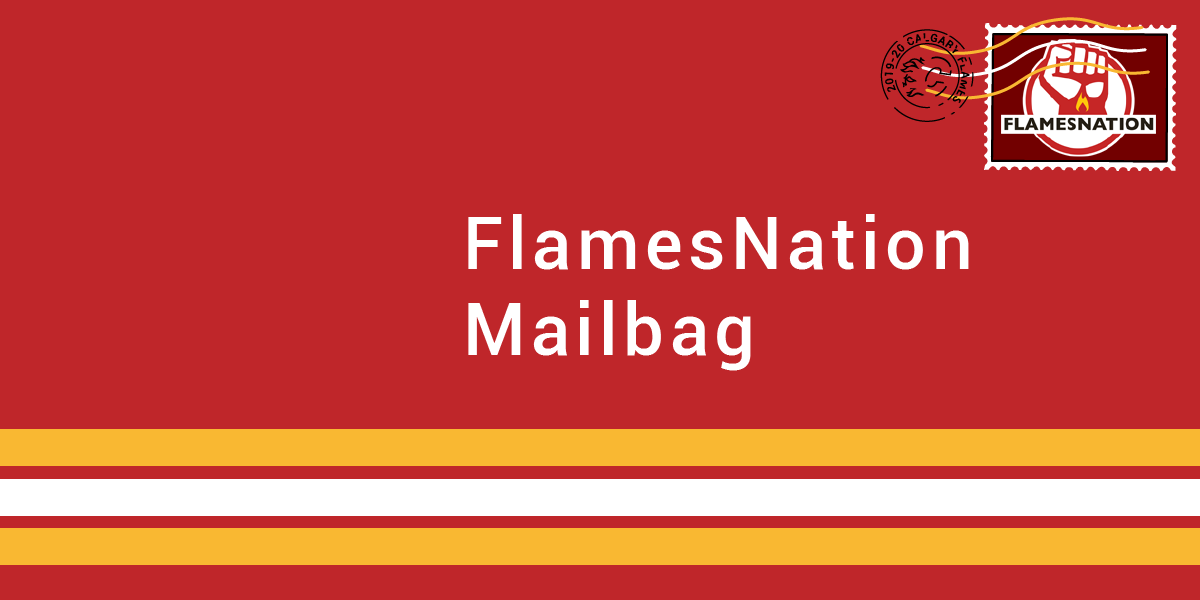What is your analysis on the coach? If you find someone better might as well do it sooner than later?
Nation Sites
The Nation Network
FlamesNation has no direct affiliation to the Calgary Flames, Calgary Sports and Entertainment, NHL, or NHLPA
FlamesNation mailbag: back from the break

The All-Star Break is over. Teams are hitting the practice ice and preparing for the resumption of regular season hostilities as they trudge towards the trade deadline.
Let’s crack open the mailbag!
Honestly, the blanket answer seems to be that the Flames are playing more on the outside than they were a year ago and are having challenges at getting into the high rent areas for high quality scoring chances. They’re also battling the percentages in the sense that not everything is going in for them – their five-on-five shooting percentage is 6.6% (29th) and their all situations shooting percentage is 8.3% (27th).
A handful of players have big gaps between their actual goals and expected goals: Mikael Backlund (-5.78), Milan Lucic (-3.37) and Sam Bennett (-2.26) lead the way. But Elias Lindholm (+8.83) is on a hot streak which cancels out a lot of the other players’ percentage-battling.
A year ago, the Flames overachieved. They had an all-situations xGF of 244.27 and they scored 289 times, 45 more than expected. This season their xGF is 135.7 and they’ve scored 130 times. They’re underachieving a little bit but they’re also not getting as many good looks – per 60 minutes their xGF was 2.96 last season and it’s a more pedestrian 2.67 this season.
In summation: they’re both less good, and less lucky than they were a year ago.
There’s likely a few different things going on at once:
- Jankowski’s an established NHL center and they know and probably feel they can work around his quirks.
- The Flames have sunk resources into developing Jankowski and likely would prefer not to risk losing him for nothing.
- The Flames want to give their young players a chance to percolate in Stockton rather than just chuck ’em into a role they might not be ready for.
That said, I agree with the premise that Jankowski looks like he lacks confidence with the puck right now. It would be ideal to send him to the farm, as he would probably clear waivers and have a chance to get his mojo back.
Nope. McKenna had the choice between playing in Kansas City of the ECHL or going back to junior as an overager, and he opted to go back to junior and so the Flames terminated his AHL deal so he could do so. (It wasn’t said to be particularly contentious, as both team and player felt it was a good move for him.)
He’s having a superb season with Moncton and it seems probable to assume that the Flames still have some interest in him.
We’ve dug into this a bit recently. With Geoff Ward, it’s so far so good. He’s 15-7-1 behind the bench, which is roughly the pace the Flames need to keep playing at in order to get into the playoffs.
In terms of the actual mechanics of the team, it’s continued to be a mixed bag. Give him credit: he hasn’t hesitated to sit guys or shuffle lines to get momentum going, and he’s managed the goaltenders pretty well. But the power play isn’t amazing and the same general structural challenges exist with their breakouts and their in-zone play, though much of that has to do with the players executing the plans rather than the plans themselves.
I would be shocked if the Flames made a (second) coaching move in-season, but much of what happens going forward depends on how the team finishes and what off-season changes happen to the roster.
100%serious here, just how safe is Treliving? If/when this club falters in another playoff with the same core he refuses to change, how many more chances does he get? Of course this does hinge on them even making the playoffs
Brad Treliving got a contract extension in October and if it’s like his prior extension, it’s for three more seasons. So Treliving is probably under contract for three more seasons. Given that, it would probably take a spectacular collapse for hm to play his way out of his new contract.
He hasn’t nailed everything, and many of the challenges the team faces in regards to the salary cap and roster construction stem from bad bets he made like James Neal or Troy Brouwer. That said, the team’s depth is much better, their drafting and development has improved by leaps and bounds, and they’re much more adept at recruiting college and European free agents than they were before his arrival. Tossing Treliving because of some underachieving core players would be throwing the baby out with the proverbial bathwater.
That said, the proximity of the Seattle expansion draft also probably helps Treliving stick around. He handled the Vegas process rather well and it would be a challenge for someone like Craig Conroy (or someone airlifted into the role from outside the organization) to wrap their head around the peculiarities of the reserve list, the roster, the team’s cap situation and the expansion draft in short order.
But if the team’s structural issues and inconsistency persist for another year, Treliving may start feeling the heat once the Grinders enter the NHL and the learning curve for a new GM becomes much less steep.
Breaking News
- What version of Jonathan Huberdeau are the Flames seeing this season?
- Wranglers series preview: Winter Wranglerfest weekend to tee up Christmas break
- Beyond the Boxscore: Flames keep struggling Kraken down with 4-2 defeat
- The Flames’ win over Seattle was the Rasmus Andersson show
- Instant Reaction: Flames overcome Kraken with third period push
